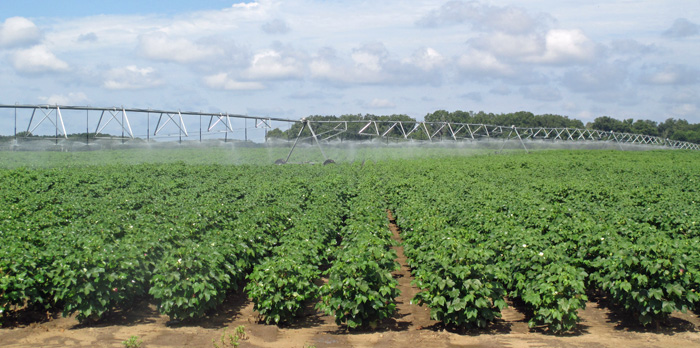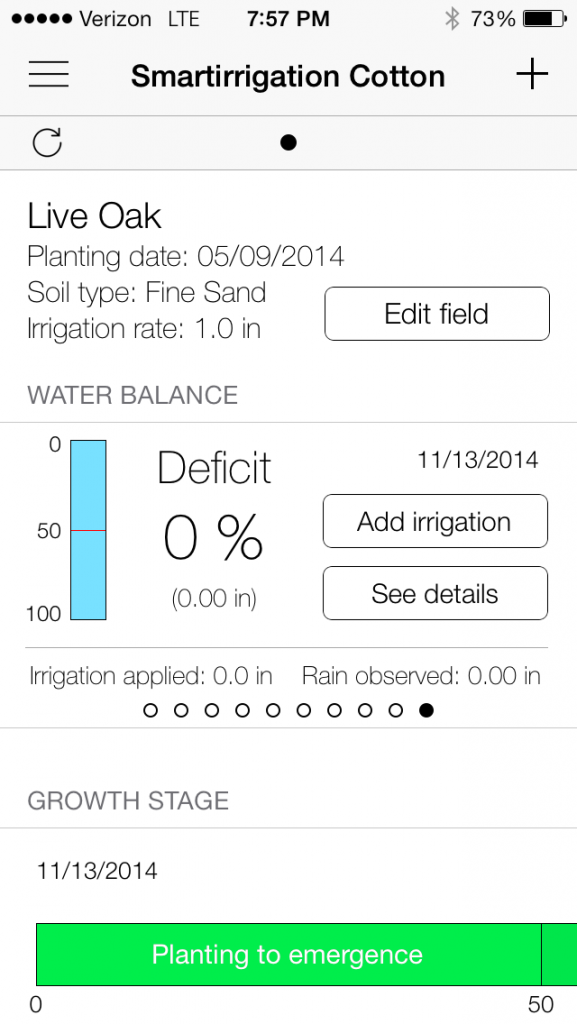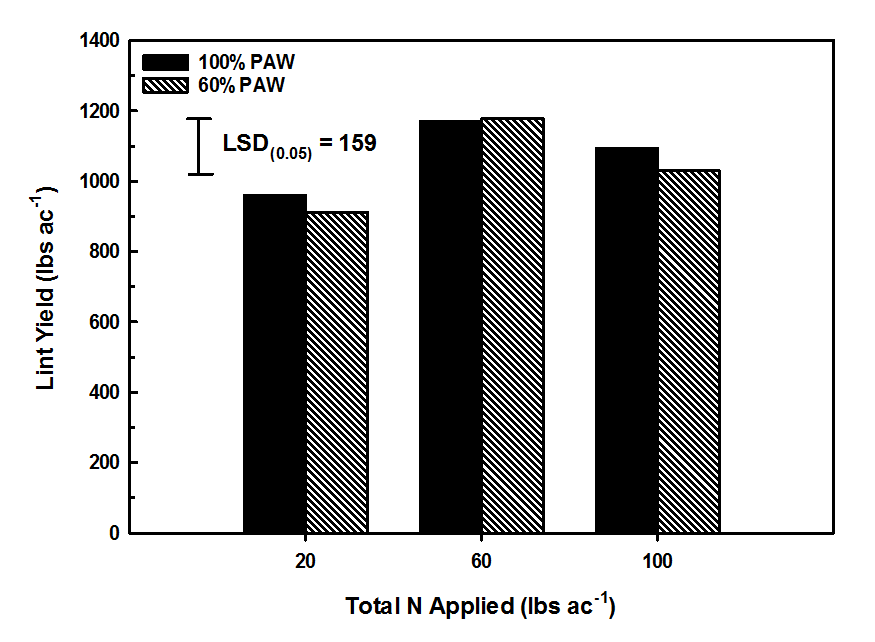
Irrigation and nitrogen fertilizer are keys to producing high yielding cotton. New scheduling tools being tested at Southeastern Universities may help farmers utilize these valuable inputs more efficiently. Photo credit: Doug Mayo
Brendan Zurweller and Diane Rowland, UF/IFAS Agronomy Department
 There are many challenges facing cotton growers in the southeast, but this year it will be even more critical to improve efficiency. This is particularly true for Florida cotton growers where water conservation has become a major statewide initiative. New research addressing irrigation scheduling is currently being conducted by University of Florida scientists in conjunction with the University of Georgia and Clemson University. The goal is to develop a standardized irrigation scheduling platform for cotton, so that growers have a common and familiar scheduling tool to use, while providing regional specific crop coefficients that optimize water conservation in each region. The platform chosen was the SmartIrrigation Cotton Application developed by Dr. George Vellidis at the University of Georgia (http://smartirrigationapps.org/). Similar trials testing the app were conducted in Florida, Georgia, and South Carolina by cooperating researchers.
There are many challenges facing cotton growers in the southeast, but this year it will be even more critical to improve efficiency. This is particularly true for Florida cotton growers where water conservation has become a major statewide initiative. New research addressing irrigation scheduling is currently being conducted by University of Florida scientists in conjunction with the University of Georgia and Clemson University. The goal is to develop a standardized irrigation scheduling platform for cotton, so that growers have a common and familiar scheduling tool to use, while providing regional specific crop coefficients that optimize water conservation in each region. The platform chosen was the SmartIrrigation Cotton Application developed by Dr. George Vellidis at the University of Georgia (http://smartirrigationapps.org/). Similar trials testing the app were conducted in Florida, Georgia, and South Carolina by cooperating researchers.
The Florida trial, lead by Brendan Zurweller a UF Ph.D. student, was conducted at the Suwannee Valley Agricultural Extension Center in Live Oak, FL. The trial compared full and reduced irrigation schedules for four cotton cultivars. Water treatments included a full irrigation treatment which replenished the depleted plant available water provided by the SmartIrrigation app, and a 40% reduction of that amount. To utilize the scheduling app, Zurweller used a 50% depletion rate of plant available water on the app for triggering irrigation. Rates varied across the season according to the effective rooting depth of the crop. While Zurweller typically monitored the app manually, growers have the option to set automated notifications, monitoring the plant-available water deficit and crop growth stages.
Because water quality is such a huge issue in this region, different levels of nitrogen applications were also tested within each of the irrigation treatments in the trial. Nitrogen (N) levels included a total amount of 20, 60, and 100 lbs of nitrogen per acre. Following the initial N application, N was applied according to the chlorophyll content measured using a SPAD chlorophyll meter (Minolta) beginning at first bloom and using a threshold value to determine optimum nitrogen application according to plant need.

Average cotton lint yield as affected by the total amount of N applied and percent of depleted plant available water replenished through irrigation (Abbreviations: 100% PAW, 100 percent of depleted plant available water replenished; 60% PAW, 60 percent of depleted plant available water replenished; LSD, least significant difference at P<0.05).
Results from the 2014 trial indicated that reductions in irrigation and nitrogen applied yielded similarly to the full rates. This indicates that increases in water use and nitrogen use efficiency were achieved in the trial using these two scheduling tools. A continuation of the research is planned in 2015, to more fully evaluate these tools. These preliminary results indicate that the irrigation scheduling app can be easily utilized by Florida and southeastern cotton growers to aid in scheduling decisions, and has the potential to achieve water conservation as well.
Get more information about the App:
Cotton Smart Irrigation App
Download a PDF of a 2014 Beltwide Cotton Conference paper describing the SmartIrrigation Cotton App.
Watch the Tutorial Video
- Rapid Response Team Deployed to Investigate Peanut Collapse - September 21, 2018
- Developing a “Stress Breathalyzer” for Peanuts - April 13, 2018
- Peanut Nodule Analysis to Assess Crop Health - August 18, 2017
